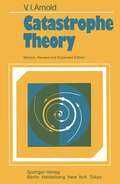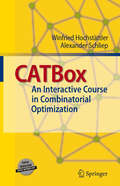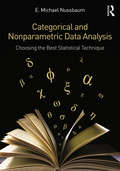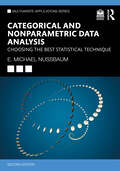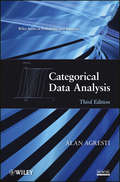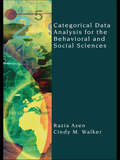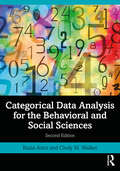- Table View
- List View
Catastrophe Theory
by Vladimir I. Arnol'dThe new edition of this non-mathematical review of catastrophe theory contains updated results and many new or expanded topics including delayed loss of stability, shock waves, and interior scattering. Three new sections offer the history of singularity and its applications from da Vinci to today, a discussion of perestroika in terms of the theory of metamorphosis, and a list of 93 problems touching on most of the subject matter in the book.
Catastrophe Theory: Second Edition
by Domencio CastrigianoCatastrophe Theory was introduced in the 1960s by the renowned Fields Medal mathematician René Thom as a part of the general theory of local singularities. Since then it has found applications across many areas, including biology, economics, and chemical kinetics. By investigating the phenomena of bifurcation and chaos, Catastrophe Theory proved to
Catastrophe Theory: Second Edition
by Domencio CastrigianoCatastrophe Theory was introduced in the 1960s by the renowned Fields Medal mathematician René Thom as a part of the general theory of local singularities. Since then it has found applications across many areas, including biology, economics, and chemical kinetics. By investigating the phenomena of bifurcation and chaos, Catastrophe Theory proved to
Catastrophic Events Caused by Cosmic Objects
by Vitaly Adushkin Ivan NemchinovAn asteroid or comet will inevitably strike the Earth some day, and potentially cause great destruction. This volume considers hazards due to collisions with cosmic objects, particularly in light of recent investigations of impacts by the authors. Each chapter, written by an expert, contains an overview of an aspect and new findings in the field. Coverage describes and numerically estimates the main hazardous effects.
CATBox: An Interactive Course in Combinatorial Optimization
by Winfried Hochstättler Alexander SchliepGraph algorithms are easy to visualize and indeed there already exists a variety of packages to animate the dynamics when solving problems from graph theory. Still it can be difficult to understand the ideas behind the algorithm from the dynamic display alone. CATBox consists of a software system for animating graph algorithms and a course book which we developed simultaneously. The software system presents both the algorithm and the graph and puts the user always in control of the actual code that is executed. In the course book, intended for readers at advanced undergraduate or graduate level, computer exercises and examples replace the usual static pictures of algorithm dynamics. For this volume we have chosen solely algorithms for classical problems from combinatorial optimization, such as minimum spanning trees, shortest paths, maximum flows, minimum cost flows, weighted and unweighted matchings both for bipartite and non-bipartite graphs. Find more information at http://schliep.org/CATBox/.
Catch up Compendium, third edition: for the life and medical sciences (PDF)
by Philip Bradley Mitchell Fry Michael HarrisThis third edition of Catch up Compendiumcontains the most up-to-date editions of the three existing Catch Upbooks: Biology, Chemistryand Maths & Stats. It provides over 600 pages of background material essential for any student studying courses in the biological and biomedical sciences. The book provides a bridge between school and university courses and provides invaluable support for the fundamental concepts covered during first year university modules. Catch Up Compendiumis a unique combination: course book, revision guide, and reference source - your first year studies will be much easier with a copy by your side.
Categorical Algebra and its Applications: Proceedings of a Conference, Held in Louvain-la-Neuve, Belgium, July 26 - August 1, 1987 (Lecture Notes in Mathematics #1348)
by Francis BorceuxCategorical algebra and its applications contain several fundamental papers on general category theory, by the top specialists in the field, and many interesting papers on the applications of category theory in functional analysis, algebraic topology, algebraic geometry, general topology, ring theory, cohomology, differential geometry, group theory, mathematical logic and computer sciences. The volume contains 28 carefully selected and refereed papers, out of 96 talks delivered, and illustrates the usefulness of category theory today as a powerful tool of investigation in many other areas.
Categorical and Nonparametric Data Analysis: Choosing the Best Statistical Technique
by E. Michael NussbaumFeaturing in-depth coverage of categorical and nonparametric statistics, this book provides a conceptual framework for choosing the most appropriate type of test in various research scenarios. Class tested at the University of Nevada, the book's clear explanations of the underlying assumptions, computer simulations, and Exploring the Concept boxes help reduce reader anxiety. Problems inspired by actual studies provide meaningful illustrations of the techniques. The underlying assumptions of each test and the factors that impact validity and statistical power are reviewed so readers can explain their assumptions and how tests work in future publications. Numerous examples from psychology, education, and other social sciences demonstrate varied applications of the material. Basic statistics and probability are reviewed for those who need a refresher. Mathematical derivations are placed in optional appendices for those interested in this detailed coverage. Highlights include the following: Unique coverage of categorical and nonparametric statistics better prepares readers to select the best technique for their particular research project; however, some chapters can be omitted entirely if preferred. Step-by-step examples of each test help readers see how the material is applied in a variety of disciplines. Although the book can be used with any program, examples of how to use the tests in SPSS and Excel foster conceptual understanding. Exploring the Concept boxes integrated throughout prompt students to review key material and draw links between the concepts to deepen understanding. Problems in each chapter help readers test their understanding of the material. Emphasis on selecting tests that maximize power helps readers avoid "marginally" significant results. Website (www.routledge.com/9781138787827) features datasets for the book's examples and problems, and for the instructor, PowerPoint slides, sample syllabi, answers to the even-numbered problems, and Excel data sets for lecture purposes. Intended for individual or combined graduate or advanced undergraduate courses in categorical and nonparametric data analysis, cross-classified data analysis, advanced statistics and/or quantitative techniques taught in psychology, education, human development, sociology, political science, and other social and life sciences, the book also appeals to researchers in these disciplines. The nonparametric chapters can be deleted if preferred. Prerequisites include knowledge of t tests and ANOVA.
Categorical and Nonparametric Data Analysis: Choosing the Best Statistical Technique
by E. Michael NussbaumFeaturing in-depth coverage of categorical and nonparametric statistics, this book provides a conceptual framework for choosing the most appropriate type of test in various research scenarios. Class tested at the University of Nevada, the book's clear explanations of the underlying assumptions, computer simulations, and Exploring the Concept boxes help reduce reader anxiety. Problems inspired by actual studies provide meaningful illustrations of the techniques. The underlying assumptions of each test and the factors that impact validity and statistical power are reviewed so readers can explain their assumptions and how tests work in future publications. Numerous examples from psychology, education, and other social sciences demonstrate varied applications of the material. Basic statistics and probability are reviewed for those who need a refresher. Mathematical derivations are placed in optional appendices for those interested in this detailed coverage. Highlights include the following: Unique coverage of categorical and nonparametric statistics better prepares readers to select the best technique for their particular research project; however, some chapters can be omitted entirely if preferred. Step-by-step examples of each test help readers see how the material is applied in a variety of disciplines. Although the book can be used with any program, examples of how to use the tests in SPSS and Excel foster conceptual understanding. Exploring the Concept boxes integrated throughout prompt students to review key material and draw links between the concepts to deepen understanding. Problems in each chapter help readers test their understanding of the material. Emphasis on selecting tests that maximize power helps readers avoid "marginally" significant results. Website (www.routledge.com/9781138787827) features datasets for the book's examples and problems, and for the instructor, PowerPoint slides, sample syllabi, answers to the even-numbered problems, and Excel data sets for lecture purposes. Intended for individual or combined graduate or advanced undergraduate courses in categorical and nonparametric data analysis, cross-classified data analysis, advanced statistics and/or quantitative techniques taught in psychology, education, human development, sociology, political science, and other social and life sciences, the book also appeals to researchers in these disciplines. The nonparametric chapters can be deleted if preferred. Prerequisites include knowledge of t tests and ANOVA.
Categorical and Nonparametric Data Analysis: Choosing the Best Statistical Technique (Multivariate Applications Series)
by E. Michael NussbaumNow in its second edition, this book provides a focused, comprehensive overview of both categorical and nonparametric statistics, offering a conceptual framework for choosing the most appropriate test in various scenarios. The book’s clear explanations and Exploring the Concept boxes help reduce reader anxiety. Problems inspired by actual studies provide meaningful illustrations of these techniques. Basic statistics and probability are reviewed for those needing a refresher with mathematical derivations placed in optional appendices.Highlights include the following:• Three chapters co-authored with Edgar Brunner address modern nonparametric techniques, along with accompanying R code.• Unique coverage of both categorical and nonparametric statistics better prepares readers to select the best technique for particular research projects.• Designed to be used with most statistical packages, clear examples of how to use the tests in SPSS, R, and Excel foster conceptual understanding.• Exploring the Concept boxes integrated throughout prompt students to draw links between the concepts to deepen understanding.• Fully developed Instructor and Student Resources featuring datasets for the book's problems and a guide to R, and for the instructor PowerPoints, author's syllabus, and answers to even-numbered problems.Intended for graduate or advanced undergraduate courses in categorical and nonparametric statistics taught in psychology, education, human development, sociology, political science, and other social and life sciences.
Categorical and Nonparametric Data Analysis: Choosing the Best Statistical Technique (Multivariate Applications Series)
by E. Michael NussbaumNow in its second edition, this book provides a focused, comprehensive overview of both categorical and nonparametric statistics, offering a conceptual framework for choosing the most appropriate test in various scenarios. The book’s clear explanations and Exploring the Concept boxes help reduce reader anxiety. Problems inspired by actual studies provide meaningful illustrations of these techniques. Basic statistics and probability are reviewed for those needing a refresher with mathematical derivations placed in optional appendices.Highlights include the following:• Three chapters co-authored with Edgar Brunner address modern nonparametric techniques, along with accompanying R code.• Unique coverage of both categorical and nonparametric statistics better prepares readers to select the best technique for particular research projects.• Designed to be used with most statistical packages, clear examples of how to use the tests in SPSS, R, and Excel foster conceptual understanding.• Exploring the Concept boxes integrated throughout prompt students to draw links between the concepts to deepen understanding.• Fully developed Instructor and Student Resources featuring datasets for the book's problems and a guide to R, and for the instructor PowerPoints, author's syllabus, and answers to even-numbered problems.Intended for graduate or advanced undergraduate courses in categorical and nonparametric statistics taught in psychology, education, human development, sociology, political science, and other social and life sciences.
Categorical Aspects of Topology and Analysis: Proceedings of an International Conference Held at Carleton University, Ottawa, August 11-15, 1981 (Lecture Notes in Mathematics #915)
by B. BanaschewskiCategorical Closure Operators (Mathematics: Theory & Applications)
by Gabriele CastelliniThis book presents the general theory of categorical closure operators to gether with a number of examples, mostly drawn from topology and alge bra, which illustrate the general concepts in several concrete situations. It is aimed mainly at researchers and graduate students in the area of cate gorical topology, and to those interested in categorical methods applied to the most common concrete categories. Categorical Closure Operators is self-contained and can be considered as a graduate level textbook for topics courses in algebra, topology or category theory. The reader is expected to have some basic knowledge of algebra, topology and category theory, however, all categorical concepts that are recurrent are included in Chapter 2. Moreover, Chapter 1 contains all the needed results about Galois connections, and Chapter 3 presents the the ory of factorization structures for sinks. These factorizations not only are essential for the theory developed in this book, but details about them can not be found anywhere else, since all the results about these factorizations are usually treated as the duals of the theory of factorization structures for sources. Here, those hard-to-find details are provided. Throughout the book I have kept the number of assumptions to a min imum, even though this implies that different chapters may use different hypotheses. Normally, the hypotheses in use are specified at the beginning of each chapter and they also apply to the exercise set of that chapter.
Categorical Constructions in Stable Homotopy Theory: A Seminar Given at the ETH, Zürich, in 1967 (Lecture Notes in Mathematics #87)
by Myles TierneyCategorical Data Analysis (Wiley Series in Probability and Statistics #482)
by Alan AgrestiPraise for the Second Edition "A must-have book for anyone expecting to do research and/or applications in categorical data analysis." —Statistics in Medicine "It is a total delight reading this book." —Pharmaceutical Research "If you do any analysis of categorical data, this is an essential desktop reference." —Technometrics The use of statistical methods for analyzing categorical data has increased dramatically, particularly in the biomedical, social sciences, and financial industries. Responding to new developments, this book offers a comprehensive treatment of the most important methods for categorical data analysis. Categorical Data Analysis, Third Edition summarizes the latest methods for univariate and correlated multivariate categorical responses. Readers will find a unified generalized linear models approach that connects logistic regression and Poisson and negative binomial loglinear models for discrete data with normal regression for continuous data. This edition also features: An emphasis on logistic and probit regression methods for binary, ordinal, and nominal responses for independent observations and for clustered data with marginal models and random effects models Two new chapters on alternative methods for binary response data, including smoothing and regularization methods, classification methods such as linear discriminant analysis and classification trees, and cluster analysis New sections introducing the Bayesian approach for methods in that chapter More than 100 analyses of data sets and over 600 exercises Notes at the end of each chapter that provide references to recent research and topics not covered in the text, linked to a bibliography of more than 1,200 sources A supplementary website showing how to use R and SAS; for all examples in the text, with information also about SPSS and Stata and with exercise solutions Categorical Data Analysis, Third Edition is an invaluable tool for statisticians and methodologists, such as biostatisticians and researchers in the social and behavioral sciences, medicine and public health, marketing, education, finance, biological and agricultural sciences, and industrial quality control.
Categorical Data Analysis (Wiley Series in Probability and Statistics)
by Alan AgrestiPraise for the Second Edition "A must-have book for anyone expecting to do research and/or applications in categorical data analysis." —Statistics in Medicine "It is a total delight reading this book." —Pharmaceutical Research "If you do any analysis of categorical data, this is an essential desktop reference." —Technometrics The use of statistical methods for analyzing categorical data has increased dramatically, particularly in the biomedical, social sciences, and financial industries. Responding to new developments, this book offers a comprehensive treatment of the most important methods for categorical data analysis. Categorical Data Analysis, Third Edition summarizes the latest methods for univariate and correlated multivariate categorical responses. Readers will find a unified generalized linear models approach that connects logistic regression and Poisson and negative binomial loglinear models for discrete data with normal regression for continuous data. This edition also features: An emphasis on logistic and probit regression methods for binary, ordinal, and nominal responses for independent observations and for clustered data with marginal models and random effects models Two new chapters on alternative methods for binary response data, including smoothing and regularization methods, classification methods such as linear discriminant analysis and classification trees, and cluster analysis New sections introducing the Bayesian approach for methods in that chapter More than 100 analyses of data sets and over 600 exercises Notes at the end of each chapter that provide references to recent research and topics not covered in the text, linked to a bibliography of more than 1,200 sources A supplementary website showing how to use R and SAS; for all examples in the text, with information also about SPSS and Stata and with exercise solutions Categorical Data Analysis, Third Edition is an invaluable tool for statisticians and methodologists, such as biostatisticians and researchers in the social and behavioral sciences, medicine and public health, marketing, education, finance, biological and agricultural sciences, and industrial quality control.
Categorical Data Analysis (Wiley Series in Probability and Statistics #482)
by Alan AgrestiAmstat News asked three review editors to rate their top five favorite books in the September 2003 issue. Categorical Data Analysis was among those chosen. A valuable new edition of a standard reference "A 'must-have' book for anyone expecting to do research and/or applications in categorical data analysis." –Statistics in Medicine on Categorical Data Analysis, First Edition The use of statistical methods for categorical data has increased dramatically, particularly for applications in the biomedical and social sciences. Responding to new developments in the field as well as to the needs of a new generation of professionals and students, this new edition of the classic Categorical Data Analysis offers a comprehensive introduction to the most important methods for categorical data analysis. Designed for statisticians and biostatisticians as well as scientists and graduate students practicing statistics, Categorical Data Analysis, Second Edition summarizes the latest methods for univariate and correlated multivariate categorical responses. Readers will find a unified generalized linear models approach that connects logistic regression and Poisson and negative binomial regression for discrete data with normal regression for continuous data. Adding to the value in the new edition is coverage of: Three new chapters on methods for repeated measurement and other forms of clustered categorical data, including marginal models and associated generalized estimating equations (GEE) methods, and mixed models with random effects Stronger emphasis on logistic regression modeling of binary and multicategory data An appendix showing the use of SAS for conducting nearly all analyses in the book Prescriptions for how ordinal variables should be treated differently than nominal variables Discussion of exact small-sample procedures More than 100 analyses of real data sets to illustrate application of the methods, and more than 600 exercises An Instructor's Manual presenting detailed solutions to all the problems in the book is available from the Wiley editorial department.
Categorical Data Analysis by Example (Spatial Data Analysis By Example Ser. #246)
by Graham J. UptonIntroduces the key concepts in the analysis of categoricaldata with illustrative examples and accompanying R code This book is aimed at all those who wish to discover how to analyze categorical data without getting immersed in complicated mathematics and without needing to wade through a large amount of prose. It is aimed at researchers with their own data ready to be analyzed and at students who would like an approachable alternative view of the subject. Each new topic in categorical data analysis is illustrated with an example that readers can apply to their own sets of data. In many cases, R code is given and excerpts from the resulting output are presented. In the context of log-linear models for cross-tabulations, two specialties of the house have been included: the use of cobweb diagrams to get visual information concerning significant interactions, and a procedure for detecting outlier category combinations. The R code used for these is available and may be freely adapted. In addition, this book: Uses an example to illustrate each new topic in categorical data Provides a clear explanation of an important subject Is understandable to most readers with minimal statistical and mathematical backgrounds Contains examples that are accompanied by R code and resulting output Includes starred sections that provide more background details for interested readers Categorical Data Analysis by Example is a reference for students in statistics and researchers in other disciplines, especially the social sciences, who use categorical data. This book is also a reference for practitioners in market research, medicine, and other fields.
Categorical Data Analysis by Example
by Graham J. UptonIntroduces the key concepts in the analysis of categoricaldata with illustrative examples and accompanying R code This book is aimed at all those who wish to discover how to analyze categorical data without getting immersed in complicated mathematics and without needing to wade through a large amount of prose. It is aimed at researchers with their own data ready to be analyzed and at students who would like an approachable alternative view of the subject. Each new topic in categorical data analysis is illustrated with an example that readers can apply to their own sets of data. In many cases, R code is given and excerpts from the resulting output are presented. In the context of log-linear models for cross-tabulations, two specialties of the house have been included: the use of cobweb diagrams to get visual information concerning significant interactions, and a procedure for detecting outlier category combinations. The R code used for these is available and may be freely adapted. In addition, this book: Uses an example to illustrate each new topic in categorical data Provides a clear explanation of an important subject Is understandable to most readers with minimal statistical and mathematical backgrounds Contains examples that are accompanied by R code and resulting output Includes starred sections that provide more background details for interested readers Categorical Data Analysis by Example is a reference for students in statistics and researchers in other disciplines, especially the social sciences, who use categorical data. This book is also a reference for practitioners in market research, medicine, and other fields.
Categorical Data Analysis for the Behavioral and Social Sciences
by Razia Azen Cindy M. WalkerFeaturing a practical approach with numerous examples, this book focuses on helping the reader develop a conceptual, rather than technical, understanding of categorical methods, making it a much more accessible text than others on the market. The authors cover common categorical analyses and emphasize specific research questions that can be addressed by each analytic procedure so that readers are able to address the research questions they wish to answer. To achieve this goal, the authors: Review the theoretical implications and assumptions underlying each of the procedures Present each concept in general terms and illustrate each with a practical example Demonstrate the analyses using SPSS and SAS and show the interpretation of the results provided by these programs. A "Look Ahead" section at the beginning of each chapter provides an overview of the material covered so that the reader knows what to expect. This is followed by one or more research questions that can be addressed using the procedure(s) covered in the chapter. A theoretical presentation of the material is provided and illustrated using realistic examples from the behavioral and social sciences. To further enhance accessibility, the new procedures introduced in the book are explicitly related to analytic procedures covered in earlier statistics courses, such as ANOVA and linear regression. Throughout each chapter the authors use practical examples to demonstrate how to obtain and interpret statistical output in both SPSS and SAS. Their emphasis on the relationship between the initial research question, the use of the software to carry out the analysis, and the interpretation of the output as it relates to the initial research question, allows readers to easily apply the material to their own research. The data sets for executing chapter examples using SAS Version 9.1.3 and/or IBM SPSS Version 18 are available on a book specific web site. These data sets and syntax allow readers to quickly run the programs and obtain the appropriate output. The book also includes both conceptual and analytic end-of-chapter exercises to assist instructors and students in evaluating the understanding of the material covered in each chapter. This book covers the most commonly used categorical data analysis procedures. It is written for those without an extensive mathematical background, and is ideal for graduate courses in categorical data analysis or cross-classified data analysis taught in departments of psychology, human development & family studies, sociology, education, and business. Researchers in these disciplines interested in applying these procedures to their own research will appreciate this book’s accessible approach.
Categorical Data Analysis for the Behavioral and Social Sciences
by Razia Azen Cindy M. WalkerFeaturing a practical approach with numerous examples, this book focuses on helping the reader develop a conceptual, rather than technical, understanding of categorical methods, making it a much more accessible text than others on the market. The authors cover common categorical analyses and emphasize specific research questions that can be addressed by each analytic procedure so that readers are able to address the research questions they wish to answer. To achieve this goal, the authors: Review the theoretical implications and assumptions underlying each of the procedures Present each concept in general terms and illustrate each with a practical example Demonstrate the analyses using SPSS and SAS and show the interpretation of the results provided by these programs. A "Look Ahead" section at the beginning of each chapter provides an overview of the material covered so that the reader knows what to expect. This is followed by one or more research questions that can be addressed using the procedure(s) covered in the chapter. A theoretical presentation of the material is provided and illustrated using realistic examples from the behavioral and social sciences. To further enhance accessibility, the new procedures introduced in the book are explicitly related to analytic procedures covered in earlier statistics courses, such as ANOVA and linear regression. Throughout each chapter the authors use practical examples to demonstrate how to obtain and interpret statistical output in both SPSS and SAS. Their emphasis on the relationship between the initial research question, the use of the software to carry out the analysis, and the interpretation of the output as it relates to the initial research question, allows readers to easily apply the material to their own research. The data sets for executing chapter examples using SAS Version 9.1.3 and/or IBM SPSS Version 18 are available on a book specific web site. These data sets and syntax allow readers to quickly run the programs and obtain the appropriate output. The book also includes both conceptual and analytic end-of-chapter exercises to assist instructors and students in evaluating the understanding of the material covered in each chapter. This book covers the most commonly used categorical data analysis procedures. It is written for those without an extensive mathematical background, and is ideal for graduate courses in categorical data analysis or cross-classified data analysis taught in departments of psychology, human development & family studies, sociology, education, and business. Researchers in these disciplines interested in applying these procedures to their own research will appreciate this book’s accessible approach.
Categorical Data Analysis for the Behavioral and Social Sciences
by Razia Azen Cindy M. WalkerFeaturing a practical approach with numerous examples, the second edition of Categorical Data Analysis for the Behavioral and Social Sciences focuses on helping the reader develop a conceptual understanding of categorical methods, making it a much more accessible text than others on the market. The authors cover common categorical analysis methods and emphasize specific research questions that can be addressed by each analytic procedure, including how to obtain results using SPSS, SAS, and R, so that readers are able to address the research questions they wish to answer. Each chapter begins with a "Look Ahead" section to highlight key content. This is followed by an in-depth focus and explanation of the relationship between the initial research question, the use of software to perform the analyses, and how to interpret the output substantively. Included at the end of each chapter are a range of software examples and questions to test knowledge. New to the second edition: The addition of R syntax for all analyses and an update of SPSS and SAS syntax. The addition of a new chapter on GLMMs. Clarification of concepts and ideas that graduate students found confusing, including revised problems at the end of the chapters. Written for those without an extensive mathematical background, this book is ideal for a graduate course in categorical data analysis taught in departments of psychology, educational psychology, human development and family studies, sociology, public health, and business. Researchers in these disciplines interested in applying these procedures will also appreciate this book’s accessible approach.
Categorical Data Analysis for the Behavioral and Social Sciences
by Razia Azen Cindy M. WalkerFeaturing a practical approach with numerous examples, the second edition of Categorical Data Analysis for the Behavioral and Social Sciences focuses on helping the reader develop a conceptual understanding of categorical methods, making it a much more accessible text than others on the market. The authors cover common categorical analysis methods and emphasize specific research questions that can be addressed by each analytic procedure, including how to obtain results using SPSS, SAS, and R, so that readers are able to address the research questions they wish to answer. Each chapter begins with a "Look Ahead" section to highlight key content. This is followed by an in-depth focus and explanation of the relationship between the initial research question, the use of software to perform the analyses, and how to interpret the output substantively. Included at the end of each chapter are a range of software examples and questions to test knowledge. New to the second edition: The addition of R syntax for all analyses and an update of SPSS and SAS syntax. The addition of a new chapter on GLMMs. Clarification of concepts and ideas that graduate students found confusing, including revised problems at the end of the chapters. Written for those without an extensive mathematical background, this book is ideal for a graduate course in categorical data analysis taught in departments of psychology, educational psychology, human development and family studies, sociology, public health, and business. Researchers in these disciplines interested in applying these procedures will also appreciate this book’s accessible approach.
Categorical Decomposition Techniques in Algebraic Topology: International Conference in Algebraic Topology, Isle of Skye, Scotland, June 2001 (Progress in Mathematics #215)
by Gregory Arone John Hubbuck Ran Levi Michael WeissThe book consists of articles at the frontier of current research in Algebraic Topology. It presents recent results by top notch experts, and is intended primarily for researchers and graduate students working in the field of algebraic topology. Included is an important article by Cohen, Johnes and Yan on the homology of the space of smooth loops on a manifold M, endowed with the Chas-Sullivan intersection product, as well as an article by Goerss, Henn and Mahowald on stable homotopy groups of spheres, which uses the cutting edge technology of "topological modular forms".

